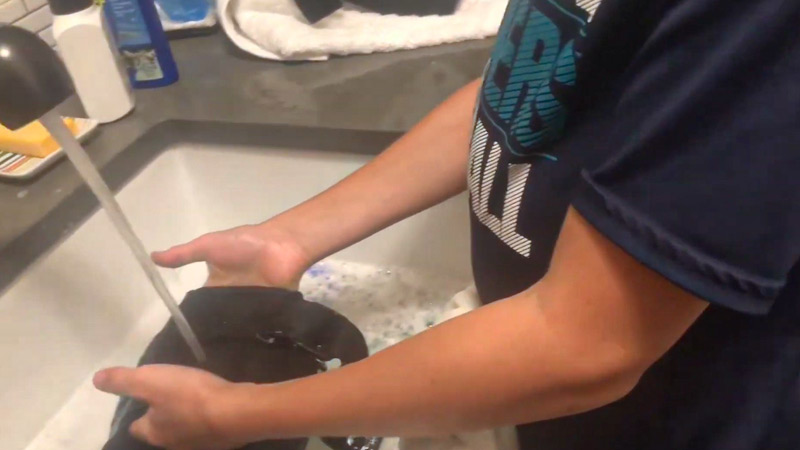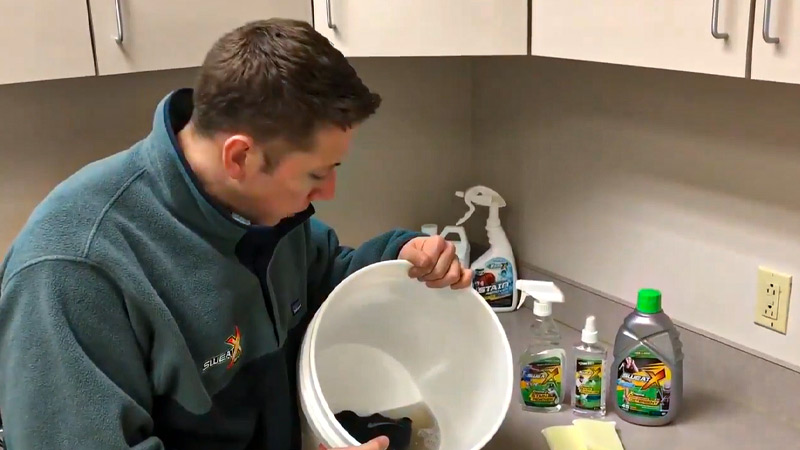Volleyball knee pads are an athlete’s trusty sidekick, providing essential protection during those heart-pounding games on the court.
But what happens when the game is over, and your knee pads are soaked in sweat, dirt, and perhaps a hint of victory? Can you wash volleyball knee pads without compromising their performance?
In this comprehensive guide, we’ll address this common query and provide answers to other frequently asked questions, ensuring you have all the information needed to keep your knee pads clean and game-ready. So, stay focused.
Can You Wash Volleyball Knee Pads?
Volleyball knee pads are essential protective gear that safeguard players from abrasions and impacts during intense matches. Over time, these pads accumulate sweat, dirt, and odor, necessitating regular cleaning.
However, the question remains: Can you wash volleyball knee pads? In this brief overview, we will explore the steps and precautions to ensure your knee pads stay clean and in optimal condition.
Cleaning volleyball knee pads is not only about hygiene but also about preserving their functionality. While it’s generally safe to wash them, the type and material of your knee pads play a crucial role in determining the best cleaning method.
Some knee pads can be machine-washed, while others require hand cleaning to avoid damaging delicate fabrics or protective padding. Additionally, choosing the right cleaning agents and following care instructions can extend the lifespan of your knee pads, keeping them fresh, and ready for the next volleyball match.
When Should You Clean Your Volleyball Knee Pads?
Cleaning your volleyball knee pads is essential to maintain their hygiene and effectiveness. Knowing when to clean them can ensure you’re always ready for peak performance on the court. Here are some key times and situations when you should clean your volleyball knee pads:
After Each Use
Ideally, you should wipe down or clean your knee pads after every volleyball match or practice session. This helps remove sweat, dirt, and bacteria that can accumulate during play.
When They Smell
If your knee pads start to emit an unpleasant odor, it’s a clear sign that they need cleaning. The odor often results from bacteria and sweat build-up, and regular cleaning can prevent this.
Visible Stains
Any visible stains on your knee pads, whether from diving on the court or contact with the floor, should prompt immediate cleaning. Stains can become permanent if left untreated.
Regular Maintenance
Even if your knee pads appear clean, it’s a good practice to schedule regular maintenance cleaning to prevent the build-up of dirt and bacteria that may not be immediately visible.
Before Tournaments or Important Matches
Ensure your knee pads are in peak condition for important games. Cleaning them before such events can provide you with the confidence of having fresh and reliable gear.
When They Become Uncomfortable
If your knee pads start feeling uncomfortable or less supportive, it may be due to dirt or sweat compromising their padding. Cleaning can restore their performance.
How to Clean Knee Pads

Cleaning volleyball knee pads is a straightforward process, but it’s important to do it correctly to ensure they remain effective and comfortable. Here’s a step-by-step guide on how to clean knee pads:
Materials You’ll Need
- Mild detergent
- Lukewarm water
- Soft-bristle brush or toothbrush
- Towels
- A basin or sink
Step-by-Step Cleaning Process
Check Care Labels
Start by checking the care labels on your knee pads, if available. Some knee pads may have specific care instructions that you should follow.
Preparation
Fill a basin or sink with lukewarm water. Avoid using hot water as it can damage the padding or fabric. Add a small amount of mild detergent to the water and mix it until it creates a soapy solution.
Submerge Knee Pads
Place the knee pads in the soapy water, ensuring they are fully submerged. Gently agitate the water to help the detergent penetrate the fabric.
Hand Wash
Use a soft-bristle brush or toothbrush to scrub the knee pads gently. Pay special attention to areas with stains or dirt buildup. Be careful not to scrub too vigorously, as this can damage the fabric or padding.
Rinse Thoroughly
After scrubbing, drain the soapy water and rinse the knee pads with clean, lukewarm water until all detergent residue is gone. You may need to rinse them multiple times to ensure thorough cleaning.
Remove Excess Water
Gently squeeze the knee pads to remove excess water. Do not wring or twist them, as this can damage the padding.
Dry Properly
Lay the knee pads flat on a clean towel to air dry. Avoid direct sunlight or heat sources, as excessive heat can degrade the materials. It may take several hours or even overnight for them to fully dry.
Check for Residue
Once dry, check for any remaining stains or odors. If needed, repeat the cleaning process.
Store Properly
Store your clean knee pads in a cool, dry place to prevent mold or mildew growth.
Remember that machine washing and drying are generally not recommended for knee pads, as the mechanical action and heat can cause damage.
How to Wash Knee Pads in Washing Machine
While hand washing is the preferred method for cleaning knee pads to ensure their longevity, some knee pads are designed to be machine-washable. If your knee pads have care labels that indicate they can be machine-washed, here’s how to do it safely:
Materials You’ll Need
- Washing machine
- Mild detergent
- Mesh laundry bag (optional)
- Towels
Step-by-Step Guide for Machine Washing Knee Pads
Check Care Labels
Before proceeding, double-check the care labels on your knee pads to confirm that they are machine-washable. Some knee pads may have specific instructions that you should follow.
Preparation
If your knee pads are especially dirty or smelly, consider placing them in a mesh laundry bag to protect them during the washing process.
Detergent Selection
Use a mild, gentle detergent that is suitable for delicate or sportswear fabrics. Avoid using harsh chemicals or bleach.
Load the Washing Machine
Place the knee pads in the washing machine, either directly or inside the mesh laundry bag. You can add other soft items like towels to balance the load and reduce friction.
Set Washing Machine
Use a gentle or delicate cycle with cold or lukewarm water. Avoid using hot water, as it can damage the padding or fabric.
Add Detergent
Pour the recommended amount of mild detergent into the detergent compartment of the washing machine.
Start the Cycle
Begin the washing cycle. Be sure to select a low spin cycle or no spin if possible to prevent unnecessary stress on the knee pads.
Rinse Thoroughly
After the washing cycle is complete, run an additional rinse cycle to ensure all detergent is thoroughly removed.
Dry Properly
Remove the knee pads from the washing machine and gently squeeze out excess water. Do not wring or twist them, as this can damage the padding. Lay them flat on a clean towel to air dry.
Avoid direct sunlight or heat sources, as excessive heat can degrade the materials. It may take several hours or even overnight for them to fully dry.
Check for Residue
Once dry, check for any remaining stains or odors. If needed, repeat the cleaning process.
Store Properly
Store your clean knee pads in a cool, dry place to prevent mold or mildew growth.
Always follow the manufacturer’s instructions and care labels when machine-washing knee pads to ensure you do not inadvertently damage them.
Can You Put Knee Pads in the Dryer?
It is not recommended to put knee pads in the dryer, especially if they have any components made of foam or padding.
The high heat and mechanical action of a dryer can potentially damage the materials and reduce the effectiveness and lifespan of your knee pads. Here’s why you should avoid putting knee pads in the dryer:
Heat Damage
The high heat in the dryer can cause the foam padding inside knee pads to break down or become misshapen, rendering them less effective in providing protection and comfort.
Fabric and Stitching
The heat and tumbling action of the dryer can also cause the fabric and stitching on your knee pads to weaken, fray, or shrink, leading to potential tears or damage.
Velcro and Straps
If your knee pads have Velcro straps or other fasteners, the heat can affect the adhesive properties of the Velcro, making it less effective over time.
Noise
Putting knee pads with hard components like plastic or metal inserts in the dryer can generate noise and potentially damage the dryer’s drum or other clothing items.
Alternative Methods
To properly dry your knee pads, follow these alternative methods:
Air Drying
After washing your knee pads, gently squeeze out excess water, lay them flat on a clean towel, and allow them to air dry at room temperature. Avoid direct sunlight or heat sources.
Hanging
You can also hang your knee pads to dry using a clothesline or hanger. Ensure they are hung in a way that allows air circulation to speed up the drying process.
Use a Fan
Placing your knee pads in front of a fan can help accelerate the drying process while avoiding the potential damage associated with a dryer.
By air drying your knee pads, you can maintain their integrity and ensure they continue to provide the protection and comfort you need during sports activities.
FAQs
How to measure volleyball knee pads?
Measuring your knee pads correctly ensures they fit snugly and provide proper protection. To measure, use a flexible tape measure or a piece of string, wrap it around your knee while it’s slightly bent, and note the circumference.
Compare this measurement to the sizing chart provided by the manufacturer for the most accurate fit.
Can I wash my knee pads if they have foam padding?
It’s generally safe to wash knee pads with foam padding, but it’s essential to follow the manufacturer’s care instructions. In some cases, hand washing may be recommended to preserve the integrity of the padding. Check the care label for specific guidance.
Should I measure my knee pads differently if they have a sleeve design?
Knee pads with a sleeve design should be measured similarly to traditional knee pads. Measure the circumference of your knee and use the manufacturer’s sizing guide to determine the appropriate size. The main difference is that sleeve-style knee pads slide over your leg like a sock.
Can I machine wash knee pads with a measurement tag?
If your knee pads have a measurement tag or label sewn onto them, it’s essential to check the care instructions provided by the manufacturer. Some measurement tags may recommend specific cleaning methods to maintain accuracy, while others may be detachable before washing.
What should I do if my knee pads feel loose after washing?
If your knee pads feel loose after washing, it could be due to stretching during the washing process. To restore a snug fit, you may need to readjust the straps or consider purchasing knee pads in a smaller size that better matches your measurements.
Wrapping Up
Whether you’re a seasoned volleyball player or a beginner just getting started, the care and maintenance of your knee pads are essential aspects of the game.
Now equipped with the answers to these frequently asked questions, you can confidently keep your volleyball knee pads clean, fresh, and always ready for that next intense match.
By following our guidance, you’ll not only ensure their longevity but also enhance your on-court performance, all while keeping discomfort and odors at bay. So, go ahead and dive into this guide, and let’s keep those knee pads in top-notch condition!







